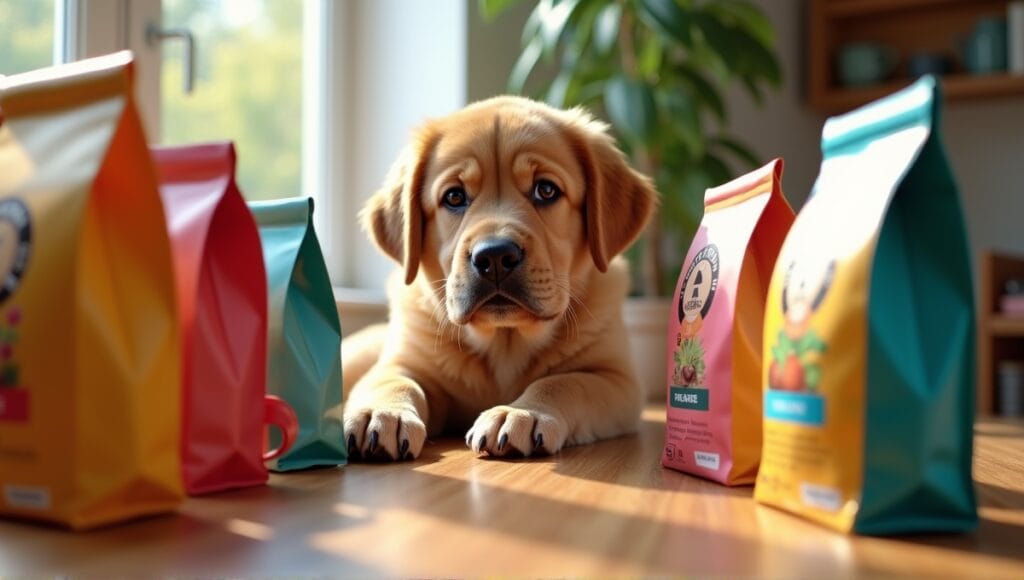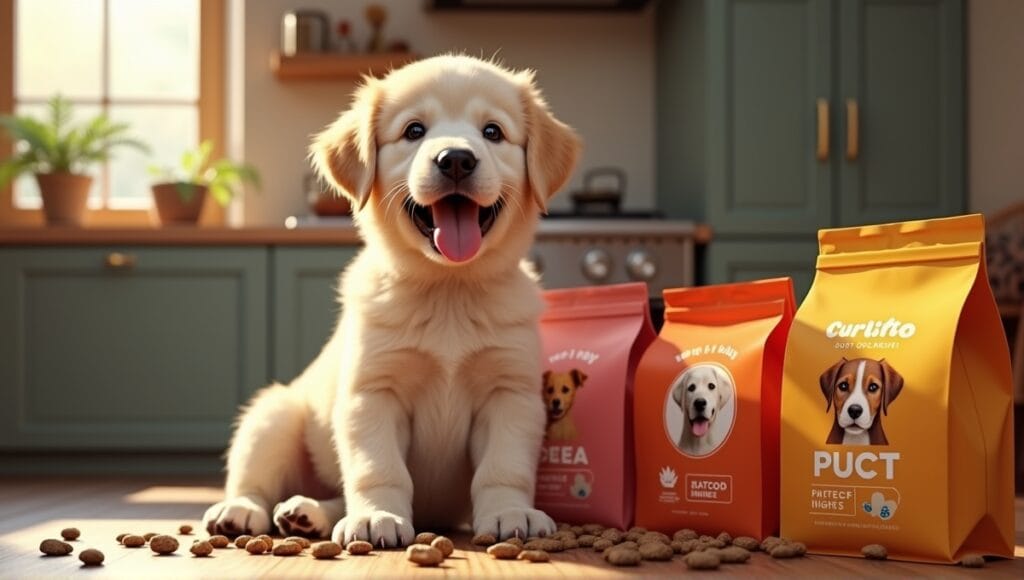Feeding a large breed puppy is different from feeding a small breed puppy as they grow so quickly and have specific nutritional requirements. I’ve studied dog nutrition for years, so I’ll share everything you need to know about large breed puppy food to ensure your large breed puppy stays healthy and continues to grow properly.
Understanding Large Breed Puppy Nutritional Needs

Large breed puppies have different nutritional requirements. Their growth patterns are very different from small breeds. I have raised many large breed puppies on our farm and at the shelter, and they grow very quickly. To prevent health issues, you need to ensure that they receive specific care.
Large breed puppies need restricted growth for the sake of their joints. Rapid weight gain will put stress on their developing bones and joints, which will increase the likelihood of orthopedic problems later on. Therefore, you should aim for slow, controlled growth.
The specific nutritional requirements for large breed puppies are:
- Protein levels: Moderate (22-26%)
- Calcium and phosphorous ratios: Balanced (1.2:1 to 1.4:1)
- Caloric density: Lower than standard puppy food
Overfeeding large breed puppies is very dangerous. Excess weight will put stress on their joints and cause developmental problems. Therefore, you must be extremely strict with portion control.
Here’s a contrast of small vs large breed growth rates:
| Age (months) | Small Breed Weight Increase | Large Breed Weight Increase |
|---|---|---|
| 0-2 | 25-30% per week | 10-15% per week |
| 2-4 | 15-20% per week | 10-12% per week |
| 4-6 | 10-15% per week | 5-8% per week |
| 6-12 | 5-10% per week | 2-4% per week |
Large breed puppies grow at a significantly slower rate over a longer period of time. This more controlled growth will help to prevent skeletal problems. As they age, you will need to adjust their food accordingly.
Key Ingredients in Large Breed Puppy Food
Quality protein sources: Large breed puppy food should contain high-quality protein sources to support muscle development. Look for named meat sources such as chicken, lamb, or fish, which provide the necessary amino acids for muscle development.
Moderate fat content: Look for a moderate fat content of about 12-15%. This balance ensures the puppy has enough energy without excessive fat content in the food. Additionally, look for essential vitamins and minerals, including:
- Calcium and phosphorus for bone development
- Vitamin D to help the puppy absorb calcium
- Antioxidants, such as vitamins E and C, to support immune function
Glucosamine and chondroitin: Glucosamine and chondroitin are essential for joint health, as they help maintain cartilage and joint fluid. This is particularly crucial in large breeds who are already prone to joint issues.
Omega-3 fatty acids (DHA): Omega-3 fatty acids, particularly DHA, support brain and eye development, making it an important nutrient in a puppy food. The most common source in dog food is fish oil.
Digestive support: Finally, look for probiotic support and digestive enzymes to support a healthy gut. Look for probiotics such as:
- Lactobacillus acidophilus
- Bifidobacterium animalis
- Enterococcus faecium
These specific strains promote a healthy gut and support overall health through nutrient absorbency. After all, a healthy digestive system is essential to a healthy puppy.
Selecting the Best Large Breed Puppy Food

Selecting the best food for your large breed puppy is important, and you should evaluate food options based on the following criteria:
- Protein source and quality
- Balanced calcium and phosphorus
- Calorie density
- Joint supporting supplements
- Brand reputation and quality control
Reading pet food labels can be challenging at first. Try to look beyond the marketing copy and dive into the ingredient list and guaranteed analysis. If the first few ingredients are high quality protein sources, you are probably on the right track.
There are AAFCO standards that ensure a product meets minimum nutritional standards. Look for foods that meet AAFCO guidelines for large breed puppy growth. This ensures the food has the right nutritional balance for large breed puppies.
Wet and dry each have their pros and cons. Dry is certainly more convenient and can help maintain dental health. Wet provides more moisture and is often more palatable. You will likely go with a combination of both for your puppy.
Grain free diets have become popular. Unfortunately, some are missing key nutrients. Consult your vet before going with a grain-free option.
There are numerous marketing ploys to avoid. Terms like “natural” or “premium” have no standard definitions. Focus on the ingredient quality and nutritional balance rather than the marketing copy.
Feeding Guidelines for Large Breed Puppies
Portion sizes will vary a little depending on your puppy’s weight and age. Here’s a general rule of thumb:
| Age (months) | Daily Food Amount (cups per 10 lbs body weight) |
|---|---|
| 2-3 | 1.5-2 |
| 4-5 | 1.25-1.5 |
| 6-8 | 1-1.25 |
| 9-11 | 0.75-1 |
| 12+ | 0.5-0.75 |
How often you feed your puppy will change as they grow. You should start with 4 meals per day for very young puppies and then slowly reduce to 3 meals per day by 4 months and then 2 meals per day by 6 months.
You’ll also need to adjust portions as your puppy grows. As a general rule of thumb, you should be able to feel (but not see) your puppy’s ribs. If you notice they’re becoming difficult to feel, reduce portions.
One easy way to prevent overfeeding is to always measure meals. Use a standard dry measuring cup to feed that amount (avoid free-feeding).
Puppies also benefit from eating meals at consistent times every day. Feeding at the same times each day can help with house training and establishing a daily routine.
Top Brands of Large Breed Puppy Food
I’ve seen many brands of large breed puppy food at the pet supply store. Quality ingredients, consistency, and customer satisfaction are the biggest indicators. Here’s how some of the leading brands compare:
| Brand | Protein Source | Calcium:Phosphorus | Price Range |
|---|---|---|---|
| Royal Canin | Chicken | 1.2:1 | $$$ |
| Hill’s Science | Chicken | 1.3:1 | $$$ |
| Purina Pro | Chicken & Rice | 1.4:1 | $$ |
| Blue Buffalo | Deboned Lamb | 1.2:1 | $$ |
| Orijen | Various Meats | 1.3:1 | $$$$ |
Price ranges vary. Higher cost doesn’t always mean higher quality. Focus on nutritional balance and ingredient quality.
Customer reviews are helpful. Look for plenty of positive feedback about puppy growth and health. Be cautious with brands that have consistently extreme positive or negative reviews.
Many veterinarians recommend Royal Canin, Hill’s Science Diet, and Purina Pro Plan. These brands have research to support their formulations.
Common Nutritional Issues in Large Breed Puppies
Fast growth can cause skeletal issues. Panosteitis and hip dysplasia are the most common. The best way to avoid both of these issues is ensuring you feed your puppy the right nutrition.
Most joint and bone problems come back to incorrect nutrition. Feeding a large breed puppy excessive calcium is just as bad as feeding too little. Stick to food specifically formulated for large breed puppies.
Many large breed puppies have digestive issues. Look for loose stools, gas, and discomfort. To combat these issues, feed your puppy a high-quality, easily digestible diet.
Food allergies might start to appear. The most common allergies are beef, chicken, and dairy. If your puppy starts itching a lot, has ear infections, or gets upset stomachs, it’s probably a food allergy.
Preventing obesity is essential. The last thing you want is your puppy to become overweight, as excess weight will damage developing joints. To avoid obesity, control portions and make sure your puppy gets plenty of exercise.
If your puppy isn’t getting the right nutrition, you might notice:
- Poor coat
- Lethargy
- Delayed growth
- Weak bones or joints
- Digestive problems
If you notice any of these signs, talk to your vet as soon as possible.
Transitioning to Large Breed Puppy Food

The switch from their mother’s milk or formula typically occurs at around 4 weeks, which is when they begin the weaning process. You can also start introducing solid food at this time.
However, you should introduce solid food gradually to prevent digestive issues.
To do this, follow these steps:
- Days 1–3: 75% old food and 25% new food
- Days 4–6: 50% old food and 50% new food
- Days 7–9: 25% old food and 75% new food
- Day 10 and beyond: 100% new food
By following these steps, you can avoid digestive issues while also ensuring that the new food is safe for your puppy.
It’s also possible that the puppy has a food sensitivity to the old food. This is a great way to determine if a particular food is causing the digestive issues the puppy’s currently experiencing.
If your puppy does experience digestive upset, slow down the transition process.
This is a good opportunity to keep a close eye on your puppy during those first few weeks and make sure they respond well to the new food. Look for normal stools, steady growth, and normal energy levels.
You can also adjust their portion size based on their body condition score.
If you notice any undesirable changes during the 10-day transition process, talk to your veterinarian for any specific guidance on selecting a new food or any applicable health issues.
Closing Remarks
Feeding large breed puppies isn’t complicated. It’s really just a matter of knowing their specific requirements and making some simple decisions. You now have the knowledge to select the right food and feed your puppy the way they should be fed. Remember, you don’t need to be a nutritionist to select the right food for your puppy. You can also use the information above to ensure you don’t overfeed your puppy. Just monitor your puppy’s body condition and adjust accordingly.
By providing the correct nutrition, you’re on track to help your large breed puppy live a healthy, happy life. You have the instincts to do this, and if you’re ever unsure about something, just ask your vet. After all, your large breed puppy is relying on you!]






